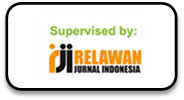Penerapan Information Gain Dan Algoritma K-Means Untuk Klasterisasi Kedisiplinan Pegawai Menggunakan Rapidminer
Abstract
Keywords
Full Text:
PDF (Bahasa Indonesia)References
D. H. Murti, N. Suciati, and D. J. Nanjaya, Clustering Data Non-Numerik Dengan Pendekatan Algoritma K-Means Dan Hamming Distance Studi Kasus Biro Jodoh, JUTI J. Ilm. Teknol. Inf., vol. 4, no. 1, p. 46, 2005, doi: 10.12962/j24068535.v4i1.a245.
Dio Prima Mulya, Analisa Dan Implementasi Association Rule Dengan Algoritma Fp-Growth Dalam Seleksi Pembelian Tanah Liat, Teknol. dan Sist. Inf. Bisnis, vol. 1, no. 1, pp. 4757, 2019.
Kusrini and E. T. Luthfi, Algoritma Data Mining, 1st ed. Yogyakarta: C.V ANDI OFFSET, 2009.
M. L. Sibuea and A. Safta, Pemetaan Siswa Berprestasi Menggunakan Metode K-Means Clustring, Jurteksi, vol. 4, no. 1, pp. 8592, 2017, doi: 10.33330/jurteksi.v4i1.28.
R. K. Dinata, H. Novriando, N. Hasdyna, and S. Retno, Reduksi Atribut Menggunakan Information Gain untuk Optimasi Cluster Algoritma K-Means, J. Edukasi dan Penelit. Inform., vol. 6, no. 1, p. 48, 2020, doi: 10.26418/jp.v6i1.37606
Suyanto, Data Mining Untuk Klasifikasi dan Klasterisasi Data, 1st ed. Bandung: INFORMATIKA BANDUNG, 2019.
U. Udayana et al., Seleksi Fitur Dalam Klasifikasi Genre Musik, J. Ilmu Komput., vol. 10, no. 1, pp. 1926, 2018.
Y. R. Sari, A. Sudewa, D. A. Lestari, and T. I. Jaya, Penerapan Algoritma K-Means Untuk Clustering Data Kemiskinan Provinsi Banten Menggunakan Rapidminer, CESS (Journal Comput. Eng. Syst. Sci., vol. 5, no. 2, p. 192, 2020, doi: 10.24114/cess.v5i2.18519.
Suraya, G. Wijayanto, A. (2022). "Comparison of Hierarchical Clustering, K-Means, K-Medoids, and Fuzzy C-Means Methods in Grouping Provinces in Indonesia according to the Special Index for Handling Stunting", Indonesian Journal of Statistics and Its Applications, VOl 6 No 2. Agustus 2022
Syukron, H. Fayyad, M. Fauzan, F. Ikhsani, Y. Gurning, U. (2022). "Perbandingan K-Means K-Medoids dan Fuzzy C-Means untuk Pengelompokan Data Pelanggan dengan Model LRFM", Malcom: Indonesian Journal of Machine Learning and Computer Science, Vol 2 No 2. September 2022
Awaludin, M. (2019). "PENERAPAN ALGORITMA K-MEANS CLUSTERING PADA K-HARMONIC MEANS UNTUK SCHEDULE PREVENTIVE MAINTENANCE SERVICE", JSI (Jurnal sistem Informasi) Universitas Suryadarma, Vol 6 No 1, Januari 2019
Article metrics
Refbacks
- There are currently no refbacks.





